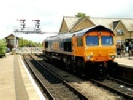Dr M.C. Duffy - account of the Lecture by John Lunn
Talk held on Tuesday 7th October 1997.
The first lecture this season was attended by seventeen members, all of whom were well rewarded, for this lecture and our distinguished speaker set a bench mark by which the rest of the season will have to be judged. The subject title is very broad and, as we were to learn, is far more complicated a than any of us could have imagined. What took place between the wars and in the United States all had a bearing on what was to take place after 1945.
Dr. Duffy started first with gas turbine locomotives; the Swiss had produced the world's first gas turbine locomotive during the war, which led to the two locomotives being constructed for the Western Region of British Rail. Other large examples of the type appeared in the United States, the Union Pacific Railroad of that country being the only Railroad to adopt turbine locomotives in fleet operation.
Dr. Duffy spoke at length about experiments conducted with variations on the turbine theme. He also spoke about various experiments made, and still being made, with coal-fired diesels. These have included tests with dry powdered coal and coal slurry (a mixture of coal dust and water). Whilst these trials have been successful, the wear rates on engines have been high. As well as dealing with gas turbines, mention was also made of some experiments being conducted during and after the war, some of which were of German origin and aimed at using lower grade fuels, such as Bunker C or low-grade coal.
Before talking about electric traction, Dr. Duffy took a look back to the interwar period. This was a period in which the Southern Railway was expanding its electrified passenger network, whilst retaining steam locomotives for freight and other non-passenger work over electrified lines. The other companies, as is now well documented, continued to refine the steam locomotive whilst operating small scale trials with diesel shunters, D.M.U.'s, etc.
Electrification or large-scale dieselisation, outside the Southern Region, was not favoured. This was much to the dismay of the diesel and electrification manufacturers, who needed a home market as a place to develop products and act as a showcase for the world. The post war world demanded change and Europe was going to be electric. In France, Andr Chapelon's plan for a series of standard steam locomotives was terminated in favour of electrification and in this country Robin Riddles, the first Chief Mechanical Engineer of the newly nationalised British Railways, was firmly in favour of large-scale electrification replacing steam. There were, however, no firm plans for main line diesels. Plans for diesel traction centred on D. M. U.'s for use on branch line and cross country services, and diesel shunters; with continued trials of the L.M.S. 10000-01 and the S.R. mainline diesels. In the United States, most railways were converting to diesel traction, with General Motors taking the lead in this market. Electrification in North America had been confined in the main to mountainous areas or in certain large tunnels, which precluded steam operation. Some of these electrification schemes were replaced by diesel traction, but in the case of the Norfolk and Western Railway, steam locomotives replaced their mountain electrification. Following a successful applications of 25Kv A.C. electrification in France, Riddles conducted experiments with this system using the Lancaster, Morecambe and Heysham line. Following these trials, the 25KV A.C. system was adopted as standard in the U.K.



